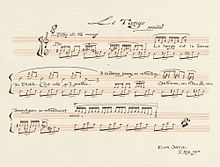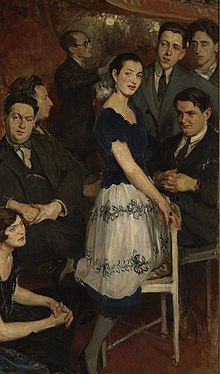Sports et divertissements
Biographer Alan M. Gillmor wrote that "Sports et divertissements is sui generis, the one work in which the variegated strands of Satie's artistic experience are unselfconsciously woven into a single fragile tapestry of sight and sound — a precarious union of Satie the musician, the poet, and the calligrapher...At turns droll and amusing, serious and sardonic, this tiny Gesamtkunstwerk affords us as meaningful a glimpse of the composer's subconscious dreamworld as we are ever likely to get.
"[4] The idea for Sports et divertissements was initiated by Lucien Vogel (1886-1954), publisher of the influential Paris fashion magazine La Gazette du Bon Ton and later founder of the famous pictorial weekly Vu.
It was conceived as an haute couture version of the livre d'artiste ("artist's book"), a sumptuous, expensive collector's album combining art, literature, and occasionally music, which was popular among French connoisseurs in the years before World War I.
[5][6] Gazette illustrator Charles Martin provided the artwork, 20 witty copper plate etchings showing the affluent at play while dressed in the latest fashions.
"Keep it short" was the only advice Satie ever gave to aspiring young composers,[14] and the necessary restrictions of the Sports album - one page per composition - perfectly suited his predilection for brevity.
Conscious of his spendthrift nature when he had money, he used this method to cover his immediate living expenses and save himself from the temptation of squandering his entire fee at once, which had happened in the past.
[24] Gillmor observed that "In several of the pieces Satie indulges in a kind of Augenmusik wherein the musical score is an obvious graphic representation of the activity being depicted.
He used the chorale form - that "symbol of Protestant piety and music pedagogy"[28] much employed by Bach - in several compositions to thumb his nose at the academic, the stupid and conformist.
Pendulum-like staccato quavers in the left hand underscore four poignant melodic phrases, including a quotation of L'escarpolette from Georges Bizet's 1871 piano suite Jeux d'enfants.
Satie's first-person narrative is one of his most whimsical literary creations, an absurdist nature-setting in which rabbits sing, nightingales hide in burrows, and owls breast-feed their young.
[41][10] In his text Satie appears to agree with the cleric's ruling by calling the tango "the Dance of the Devil", but then adds a droll glimpse of Satan's domestic life: "It's his favorite.
As a final joke the repeat signs at the beginning and end of the score indicate the piece is to be played ad infinitum, presenting a hellish eternity of musical monotony.
Satie's music for the sled speeding along is purely descriptive - a series of skittering, frenetic bursts covering most of the keyboard - while the commentary is mostly concerned with the icy conditions: "Ladies, keep your noses inside your furs...The landscape is very cold and doesn't know what to do with itself."
The music, while depicting the back-and-forth of the players, is strangely dark and ambiguous; and the implied eroticism that pervaded the choreography of Jeux is trivialized in Satie's text, in which the spectator-narrator mixes prosaic sensual observations ("What good-looking legs he has...what a fine nose") with correct sports terminology ("A slice serve!").
Fashions and graphic design had changed dramatically in the intervening years, so Charles Martin was commissioned to replace his original illustrations with a new set of drawings in a Cubist-influenced style; these were rendered into full-color pochoir prints at the studio of Jean Saudé, a leading practitioner of the technique.
The very rare first set, copies 1 to 10, included both Martin's original 1914 illustrations and his 1922 pochoir prints, his engraved Table of Contents and individual title pages, and cameos decorating the latter.
[55] In 1926, Rouart, Lerolle & Cie purchased the rights for Sports from Vogel and brought out a standard performing edition, with Satie's facsimile scores in black ink only and without Martin's illustrations.
[56][57] While he eschewed standard compositional development and structure, Satie was highly aware of the formal "architecture" of his music and sequenced his multi-movement works with great care.
[61] An almost complete set (minus Le Traîneau) was presented in Volta's edition of Satie's literary writings, A Mammal's Notebook (1996), making the bulk of Martin's original work available for the first time.
When the first commercial performing edition appeared in 1926, Satie was dead and his growing reputation as a serious composer had been tarnished by the widespread critical condemnation of his last work, the Dada ballet Relâche (1924).
[63] While Satie's music faded from Parisian concert programs of the late 1920s and early 1930s,[64] Sports quietly circulated among musicians and faithful fans, some of whom immediately recognized its importance.
"[66] Myers continued, "Satie here proves himself an artist of the finest quality, working to a scale which in itself would be a handicap to most writers, let alone musicians, but triumphing over his self-imposed limitations with the virtuosity of a marksman scoring a bull's-eye with each shot.
It is worth noting that in his next composition, the piano suite Heures séculaires et instantanées (written June – July 1914), he issued his famous "warning" to the players forbidding them from reading his extramusical texts aloud during the performance.
On December 14, 1919, Lucien Vogel and his wife held a private musical soirée at their Paris apartment which included "a few little novelties, entitled Sports & Divertissements, by M. Erik Satie.
It was part of a three-concert series in which Meyer presented Satie's music in historical contexts, from the early clavecin masters to the contemporary avant-garde; Sports was programmed with piano pieces by members of Les Six.
[70] This was followed by the United States premiere at the Klaw Theatre in New York City on February 4, 1923, sponsored by Satie champion Edgard Varèse through the auspices of his International Composers Guild.
[72] Patrick Gowers, writing for The New Grove Dictionary of Music and Musicians in 1980, described the multi-faceted yet intimate nature of Sports et divertissements as "a private art that tends to resist public performance.
Composer-critic Virgil Thomson, one of Satie's foremost American champions of the 20th Century, began performing Sports as a work for "narrator and piano" in New York City in the mid-1950s.
"[77] Since then performances of Sports for voice and piano have been supplemented by arrangements for "speaker and ensemble," including chamber orchestra versions by composers Dominic Muldowney (1981) and David Bruce (2008).
"[81] Recordings include those by Jean-Joël Barbier (BAM, 1967), Aldo Ciccolini (twice, for Angel in 1968 and EMI in 1987), Frank Glazer (Vox, 1968, reissued 1990), William Masselos (RCA, 1969, reissued 1995), John McCabe (Saga, 1974, reissued by Decca, 1986), Yūji Takahashi (Denon, 1979), France Clidat (Forlane, 1980), Jean-Pierre Armengaud - two versions: piano only (Le Chant du Monde, 1986), and with Claude Piéplu narrating (Mandala, 1996), Anne Queffélec (Virgin Classics, 1988), Yitkin Seow (Hyperion, 1989), João Paulo Santos (Selcor, 1991, reissued 1999), Gabriel Tacchino (Disques Pierre Verany, 1993), Michel Legrand (Erato Records, 1993), Klára Körmendi (Naxos Records, 1994), Bojan Gorišek (Audiophile Classics, 1994), Jean-Marc Luisada with Jeanne Moreau as narrator (Deutsche Grammophon, 1994), Olof Höjer (Swedish Society Discofil, 1996), Pascal Rogé (Decca, 1997), Peter Dickinson (Olympia, 2001), Eve Egoyan (CBC, 2002), Jean-Yves Thibaudet (Decca, 2003), Håkon Austbø (Brilliant Classics, 2006), and Marielle Labèque (KML, 2009).










